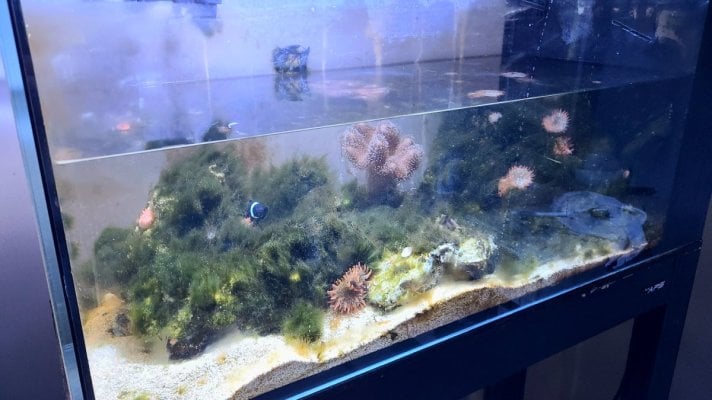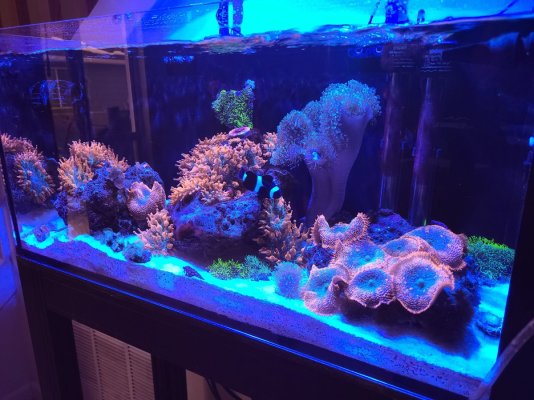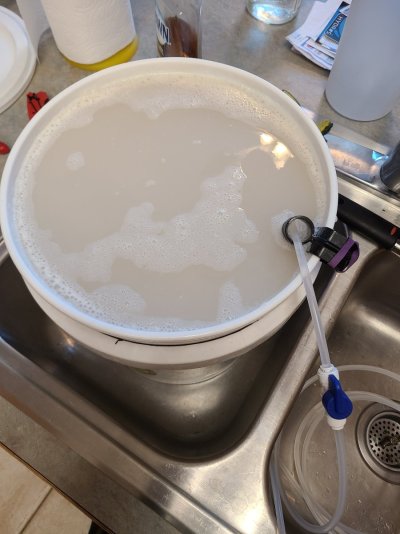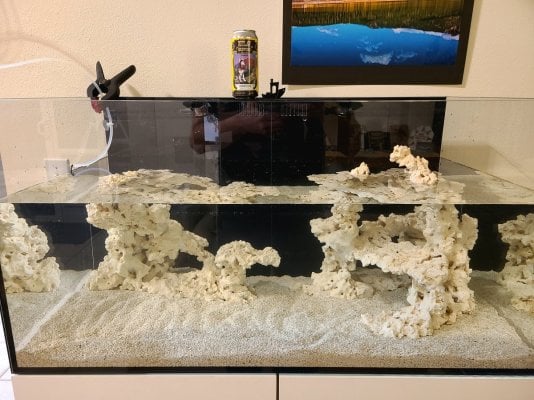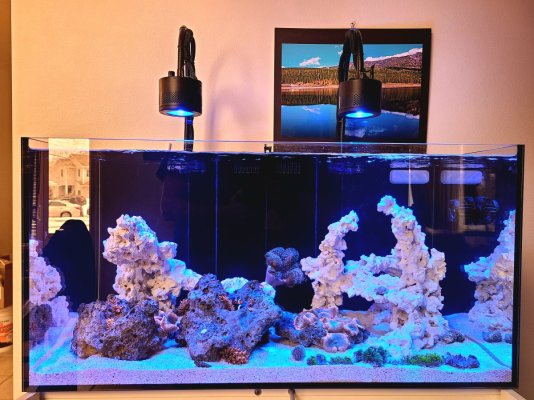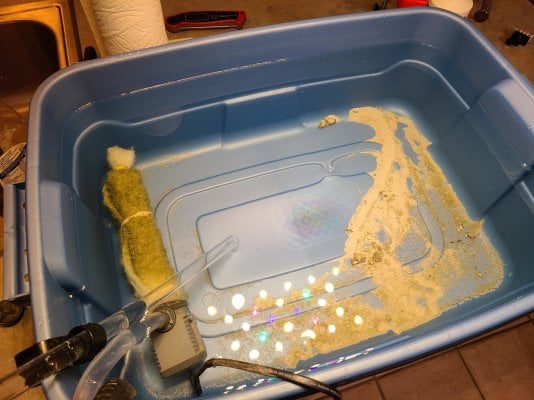that much live rock carries any bioload in reefing= the basis for our plan.
when you move to a larger tank that's + more dilution and less waste presentation per unit of measure to the rock surfaces so it's no challenge to just relocate it as we've been doing.
scrape it clean of any algae for a fresh start in the new tank.
make sure that receiving tank sand is snowglobe clean rinsed/who wants clouding at the start of a new tank it's a total let down/that sand rinse coming up will be the lion's share of hours spent getting ready. make sure that you verify in a clear glass of water occasional samples of your rinsed sand so that it's perfect, start days early prepping the sand it'll take days of rinsing. we do 100% perfect rinsing as our unifying factor here to keep the thread and the outcomes on track.
you don't want to go through all this rinse effort, then fill up your tank and it's still cloudy.
testing repeat portions of your rinse prepped sand in a large clear container like this proves your whole lump is ready to go:
*you do not have to expend effort getting new rocks ready for cycling by adding bacteria*
that's where new cycling science helps you and saves concern and cost.
new rock added does not have to be cycled because the current rocks wouldn't lack carry ability even if you removed a third of them, we've done that in jobs here prior years. created nsa scapes out of huge rock stacks/no recycle/no loss.
*here are two hidden risks I'd like to relay having nothing to do with the actual ammonia control:
1. a trend is emerging in the disease forum where non prepped tanks, that's tanks that did not run fallow and quarantine to carry their current fish load (which do fine in the tank as it sits daily) get expressed disease outbreak when they disturb the system and move to a new tank. latent fish disease happens more and more nowadays, and it has nothing to do with skip cycling for ammonia. be prepared. if you used fallow/quarantine + biosecurity plans Jay mentions on this current tank, I do not expect that in the new system.
2. Any white rock you add brings in the common phosphate issues found/invasion issues found when dealing in non coralline rock. you are likely to get algae outbreaks on that white rock and it may carry over to other surfaces, but then again having a totally cloudless sandbed up under it all allows you to remove rocks and guide them externally and set back, without clouding or messing up your new tank with a huge dust storm. pre soaking that rock in water doesn't really reduce this very much, you're about to add highly reflective bright surfaces into a tank of muted purple/darker tone rocks and the white ones are likely to catch some uglies.
I want to link in a thread now where Tuffloud simply guided an entire white rock aquascape into a master reef tank handling all the uglies inside the tank, never having to remove rocks for guiding because he's reef picasso.
I can guarantee your biofilter will skip cycle for those fish but we'll need his scape tuning to avoid algae outbreaks
study his deft guiding of 200 pounds of white rock into a perfect sps system:

 www.reef2reef.com
www.reef2reef.com
when you move to a larger tank that's + more dilution and less waste presentation per unit of measure to the rock surfaces so it's no challenge to just relocate it as we've been doing.
scrape it clean of any algae for a fresh start in the new tank.
make sure that receiving tank sand is snowglobe clean rinsed/who wants clouding at the start of a new tank it's a total let down/that sand rinse coming up will be the lion's share of hours spent getting ready. make sure that you verify in a clear glass of water occasional samples of your rinsed sand so that it's perfect, start days early prepping the sand it'll take days of rinsing. we do 100% perfect rinsing as our unifying factor here to keep the thread and the outcomes on track.
you don't want to go through all this rinse effort, then fill up your tank and it's still cloudy.
testing repeat portions of your rinse prepped sand in a large clear container like this proves your whole lump is ready to go:
*you do not have to expend effort getting new rocks ready for cycling by adding bacteria*
that's where new cycling science helps you and saves concern and cost.
new rock added does not have to be cycled because the current rocks wouldn't lack carry ability even if you removed a third of them, we've done that in jobs here prior years. created nsa scapes out of huge rock stacks/no recycle/no loss.
*here are two hidden risks I'd like to relay having nothing to do with the actual ammonia control:
1. a trend is emerging in the disease forum where non prepped tanks, that's tanks that did not run fallow and quarantine to carry their current fish load (which do fine in the tank as it sits daily) get expressed disease outbreak when they disturb the system and move to a new tank. latent fish disease happens more and more nowadays, and it has nothing to do with skip cycling for ammonia. be prepared. if you used fallow/quarantine + biosecurity plans Jay mentions on this current tank, I do not expect that in the new system.
2. Any white rock you add brings in the common phosphate issues found/invasion issues found when dealing in non coralline rock. you are likely to get algae outbreaks on that white rock and it may carry over to other surfaces, but then again having a totally cloudless sandbed up under it all allows you to remove rocks and guide them externally and set back, without clouding or messing up your new tank with a huge dust storm. pre soaking that rock in water doesn't really reduce this very much, you're about to add highly reflective bright surfaces into a tank of muted purple/darker tone rocks and the white ones are likely to catch some uglies.
I want to link in a thread now where Tuffloud simply guided an entire white rock aquascape into a master reef tank handling all the uglies inside the tank, never having to remove rocks for guiding because he's reef picasso.
I can guarantee your biofilter will skip cycle for those fish but we'll need his scape tuning to avoid algae outbreaks
study his deft guiding of 200 pounds of white rock into a perfect sps system:

Connecting Established Reef To New Tank
EDIT: In conclusion, if using the method I did - connecting an established reef to a new system with dry rock (clean), I recommend the following: 1. Dose your new tank prior to connecting to your old tank with NO3 and PO4 enough to raise to your established tank levels. 2. Take your skimmer...
 www.reef2reef.com
www.reef2reef.com
Last edited:








